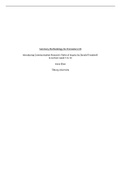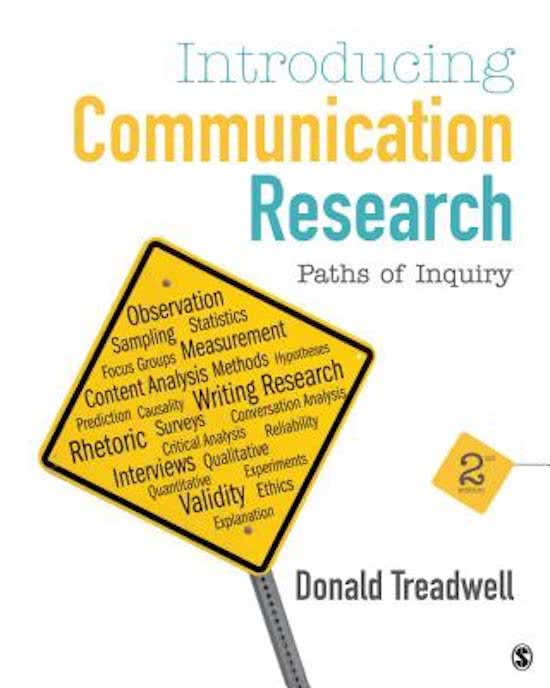Summary Methodology for Premasters CIS
Introducing Communication Research: Paths of Inquiry by Donald Treadwell
& Lecture week 1 to 14
Irene Elion
Tilburg University
,Week 1, 2 & 3 (ch. 1 +2)
Scientific research starts with an interest or question about phenomena, situations, or
behavior.
Research questions can be of all kinds:
Open-ended question
Closed-ended question
A literature review is used to find out what’s already known about the topic.
There are different ways of approaching a decription/explanation
(‘worldviews’/’epistemologies’).
provides it own attempt to describe or explain the phenomenon/situation/behavior or
tests and existing description/explanation.
There are different type of worldviews:
1. Nomothetic approach: one who establishes=
Human behavior is generalizable, predictable, and motivated by events, personality,
and other people.
Understanding behavior is best done by isolating factors.
2. Idiographic approach: to write =
Each person is unique, unpredictable, and self-motivated
Understanding behaviour is best done from the participant’s perspective and by
considering the whole situation.
Creswell and Creswell (2018) indentify four worldviews:
1. Postpositive: challenges the notion of absolute truth but emphasizes cause and effect and
the idea that the world is governed by laws and theories that can be tested or verified. Uses
quantitative methods.
2. Constructivist: individuals seek understanding of the world in which they live and
construct their own views of it. Uses qualitative methods.
3. Transformative: change oriented and argues for mixing research with politics to confront
social oppression and change lives for the better.
4. Pragmatism: focuses on solutions to problems and using all possible approaches to
understanding these problems. It does not commit to any one basic philosophy and
embraces mixed-method approach.
Traditions of communicative research (Communication metatheory):
Rhetorical
Semiotic
Phenomenological
Cybernetic
Sociopsychological
Sociocultural
Critical
Research methods
,Quantitative research methods
= build around the idea that human traits and behaviors can be translated into numbers to
analyse them.
= surveys, experiments, content analysis
Qualitative research methods
= build around the idea that human traits and behavior are best understood by observing
and interviewing people
= interviews, focus groups, case studies, observational studies
Induction, deduction, abduction
Links observations with theories
Induction
Reasoning from the particulars to the general
Theory building/hypothesis generation/explanation
Specific to general
Deduction
Reasoning from the general to the particulars
Theory/hypothesis testing
General to specific
Abduction
Similar to induction
Inference the best explanation
Affect to possible causes
Properties of a good theory:
Can be falsified
o E.g., Social Information Processing theory (SIP): explains how people interact
and form impressions about each other in online/digital settings, with a focus
on the types of cues that are available.
Generates hypothese
o E.g., verbal cues will have a stonger influence on impression formation in a
digital setting than in a face-to-face setting
Covers a broad area
Is substantiated by converging evidence
o When different types of data and studies point in the same direction, the
theory is more plausible.
Hypotheses:
- Specifiy the relation we expect to find, e.g.:
o Correlation: relation between variables causes effect
o Causation: causation between variables that causes effect
o One-tailed/two-tailed: one part or two parts of hypothesis is true
, o Null hypothesis: no effect at all
- Are not usually said to be ‘true’ or ‘false’, but supported (by the available evidence) to a
Certain extent can be tested
Variables: In a typical study, you are interested in the relation between different concepts.
When these concepts are abstract ideas, such as ‘attitude’, ‘motivation’, or ‘appreciation’,
they are often referred to as constructs.
Dependent variable (DV) = also known as the outcome variable.
= the variable whose relation to other variables the researcher is interested in.
Independent variables (IV) = might cause or correlate with variation in the outcome
variable & often manipulated by the research.
An IV can have 2 or 3 levels, but more levels are certainly possible.
Interaction: moderation and mediation
Sometimes the effect of one IV on the DV depends on the level of the other IV.
If you cannot state what the effect of one IV is without mentioning the other IV, there is an
interaction effect. E.g.,
o Writers of texts with language errors are perceived as less attractive than those
of error-free texts, but only if the profile does not contain a picture.
Moderation is a special case of interaction.
The strength and/or direction of the effect off an IV on a DV may depend on the level of a
moderating variable = whose own effect on the DV we are not necessarily interested in &
which is often observed, rather than manipulated.
Mediation is when the effect of IV on DV is indirect. The IV has an effect on the mediating
variable, which in turn has aneffect on the DV.
There is also a third variable problem = correlation=/causation. When reading about a
study, always ask yourself: could there be a ‘third’ variable that explains the relation
between two variables.
Research has several broad purposes:
1. Exploration = curiosity-based research.
2. Description = description-based research
3. Explanation = attempt to answer the “why” question
4. Prediction = predict the question and answer
5. Control = researching with a view to be able to predict and manipulate physical processes
6. Interpretation = can be understood as attempts to place yourself in another person’s
shoes.
7. Criticism = to understand and explain the way in which communication is used to exercise
and maintain power in groups, organizations, and societies.
Week 4 (ch. 10)






